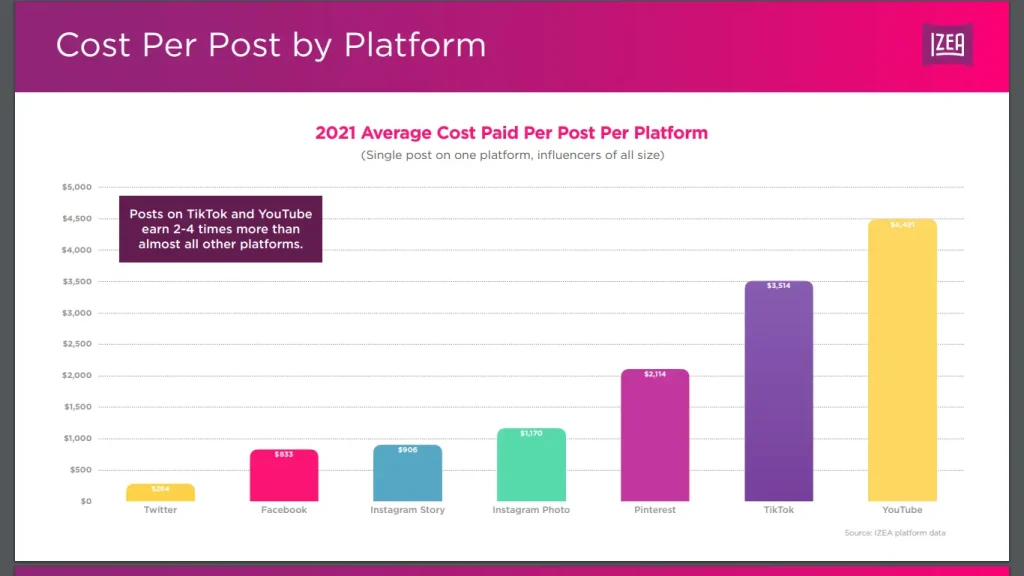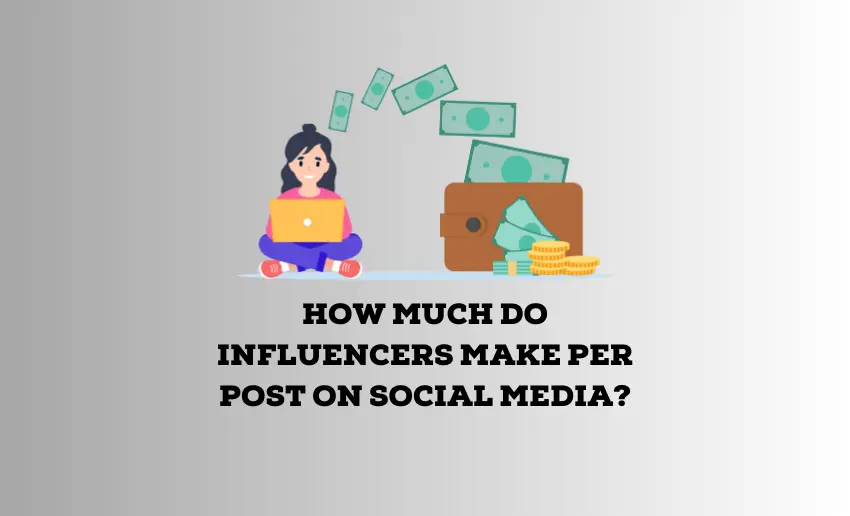Social media influencers have become the stars of the online world with their captivating content and relatable personalities. But have you ever wondered just how much do influencers make per post on social media platforms like Instagram, Twitter, or TikTok?
It’s a question that piques the curiosity of many, and over time, several figures have been thrown around. In this article, I’ll dive into the world of influencer earnings by looking behind the numbers and exploring the factors that influence their income.
Smaller influencers with around 10,000 to 50,000 followers can make $50 to $500 per post. As follower counts grow, so do potential earnings. Mid-tier influencers with 50,000 to 500,000 followers may earn $500 to $5,000 per post. Mega-influencers, with millions of followers, can make $10,000 or more per post. However, these are just general estimates, and earnings depend on several factors.
Influencers’ earnings per social media post vary widely. Negotiating rates and understanding one’s worth play a crucial role in determining influencer earnings. A recent report in 2021 by IZEA suggests that average cost paid per post typical price for a sponsored TikTok post stands at $3,514, while that of YouTube averages $4,491 for each video.

Some influencers also earn money through affiliate marketing and product placements, contributing to their overall income.
7 Factors affecting Influencer earnings
1. Follower count
In the influencer world, the number of followers directly impacts earnings. Generally, the more followers an influencer has, the more they can charge for each post. This is because they have a larger reach and can potentially influence a broader audience. However, even micro-influencers with smaller followings can earn well if they have highly engaged and loyal followers. It’s not just about the quantity; quality matters, too.
2. Niche and industry
The specific industry or niche an influencer operates in plays a vital role in determining their earnings. Influencers in popular and lucrative niches, such as fashion, beauty, or technology, often command higher rates compared to those in smaller or less competitive niches. Brands are willing to pay more when their target audience aligns closely with the influencer’s content, making niche choice a significant factor in influencer earnings.
3. Follower engagement
While having a large follower count is essential, it’s not the only factor. Follower engagement, including likes, comments, and shares, also influences earnings. An influencer with a smaller following but a highly engaged audience can often charge more per post because their content genuinely resonates with their followers. Brands value this authentic connection and are willing to invest in it.
4. Platform choice
The social media platform an influencer primarily uses can impact their earnings. Instagram, Twitter, YouTube, and TikTok, for example, offer different monetization opportunities. YouTube generally has higher ad revenue potential, while Instagram is popular for sponsored content. This is because creating video content demands more time and resources than simple images or text-based posts. Influencers who diversify and use multiple platforms can maximize their overall earnings.
5. Geographical location
Where an influencer is based geographically can also influence their earnings. The cost of living and market demand vary worldwide. Influencers living in high-cost urban areas or countries with strong influencer markets might command higher rates than those in lower-cost regions or markets with less competition.
6. Content type
Influencers create various types of content, from sponsored posts to affiliate marketing and product placements. Different content types can yield varying earnings. Sponsored posts typically offer direct income, while affiliate marketing may provide commissions based on sales generated. Understanding the potential income from each content type is crucial for influencers seeking to optimize their earnings.
7. Negotiating skills
In the influencer world, the art of negotiation can significantly impact earnings. Knowing one’s worth and confidently discussing rates with brands can lead to better deals. Influencers who can communicate the value they bring to the table effectively are often better positioned to secure higher-paying partnerships, resulting in increased earnings per post.
How much do Instagram, TikTok, and Twitter (X) influencers earn per post?
The earnings of influencers on popular platforms like Instagram, TikTok, and Twitter ( now X) per post can vary significantly based on several factors discussed above. Here is a breakdown of potential earnings:
- Nano-influencers (less than 1,000 followers) can earn around $10 to $100 per post.
- Micro-influencers (1,000 to 10,000 followers) typically make between $100 and $500 per post.
- Mid-tier influencers (10,000 to 100,000 followers) can earn anywhere from $500 to $5,000 per post.
- Macro-influencers (100,000 to 1,000,000 followers) often make between $5,000 and $10,000 per post.
- Mega-influencers (1,000,000 or more followers) can command $10,000 or more for each post.
How do Influencers make money?
Social media influencers make money in a number of ways. As said before, what an influencer earns is dependent on their monetization technique. That said, here are a couple of proven methods for influencer earning:
1. Sponsored posts
Influencers make money through sponsored posts by partnering with brands to promote their products or services. Sponsored posts are a common way for influencers to monetize their social media presence. Brands pay influencers to create and share content featuring their offerings. The influencer’s content typically includes images, videos, or written posts that showcase the product or service.
2. Affiliate marketing
Affiliate marketing is another income source for influencers. Here, influencers promote products or services through unique affiliate links provided by brands. When their followers make a purchase using these links, the influencer earns a commission on the sale. The more sales generated through their affiliate links, the more money influencers can earn. This method is effective because it aligns with the influencer’s content and provides a way to earn audience trust and genuine recommendations.
3. Product placements
Influencers often incorporate products into their content naturally. This can involve subtly featuring products in their posts, videos, or stories. Brands pay influencers for these product placements, as it allows them to reach the influencer’s engaged audience in a non-disruptive way. The influencer showcases the product seamlessly, making it a more authentic form of promotion. Earnings from product placements vary based on factors such as the influencer’s reach and the brand’s budget.
4. Collaborations and partnerships
Influencers frequently collaborate with brands and businesses on long-term partnerships. These collaborations can take various forms, such as brand ambassadors, sponsored series, or exclusive content creation. These partnerships often involve ongoing compensation, free products, or other benefits. By forming strong, enduring relationships with brands, influencers ensure a consistent income stream while creating content that resonates with their audience.
5. Off-site website advertising
Some influencers expand their revenue streams by running their websites or blogs. They can earn money through advertising on these platforms, which may include banner ads, affiliate links, or sponsored content. While these earnings may not be as direct as those from social media, they provide an additional source of income. Off-site website advertising can be particularly lucrative for influencers who have built a dedicated audience interested in their blog or website content.
How much should I charge as an influencer?
Determining your influencer rates can be a complex process and depends on factoring in several points. Additionally, pricing can be flexible, and it’s okay to adjust your rates as you gain experience and a better understanding of your value in the influencer market.
To help you get started, here are a few pointers to helping you determine the optimal rate:
1. What kind of content is required?
Influencers should consider the type of content they’re creating when determining their price. Some content, like high-quality videos or elaborate photo shoots, requires more effort, time, and resources. Therefore, influencers may charge more for these posts compared to simpler content. Additionally, the complexity of the content and the skills involved, such as editing or scripting, play a role in setting the price.
2. What’s the industry average?
Influencers often research industry standards and average rates for similar content in their niche. This benchmarking helps in establishing a competitive but fair price. The industry average considers factors like platform, follower count, and content type. Influencers may adjust their rates based on whether they are above or below the average in terms of experience and engagement.
3. Number of reach or follower Size
Follower count is a crucial factor in pricing. Influencers with a larger following can typically charge more because their content reaches a broader audience. Brands are willing to invest more in influencers who can potentially expose their products or services to a substantial number of people. A high follower count often correlates with higher rates for influencers.
4. Engagement rates from previous campaigns
Engagement rates, which include likes, comments, and shares, can be just as important as follower count. An influencer with a smaller but highly engaged audience may command higher rates. If you can demonstrate a track record of effective campaigns where your audience actively interacts with your content and converts into customers, you have a strong bargaining position to charge more for your services.
5. What does your portfolio look like?
Influencers use portfolios to showcase their value to potential brand partners. A portfolio typically includes key statistics like follower demographics, engagement metrics, previous brand collaborations, and examples of their work. The more impressive and informative the portfolio, the better an influencer can negotiate rates. It serves as a persuasive tool to demonstrate the influencer’s professionalism and the value they bring to the table.
How much do influencers make with 1 million followers?
A mega-influencer who has 1 million followers can earn quite a bit for sponsored posts. Their earnings can vary, typically falling in the range of $5,000 to $25,000 or even more. According to the Instagram Rich List by Hopper HQ, most influencers with over a million followers tend to charge around $10,000 to $15,000 for each sponsored post. However, top-tier influencers with exceptional engagement, a strong niche focus, and a loyal following may command even higher rates.
To Summarize
Influencer earnings per social media post is a dynamic landscape where numerous factors come into play. Follower count, engagement, content type, and industry niche all contribute to an influencer’s earning potential. For those considering this path, the potential to turn a passion into a profession remains promising. While the numbers can vary significantly, the stories of successful influencers, both big and small, serve as motivation and a testament to the opportunities within this digital space.








